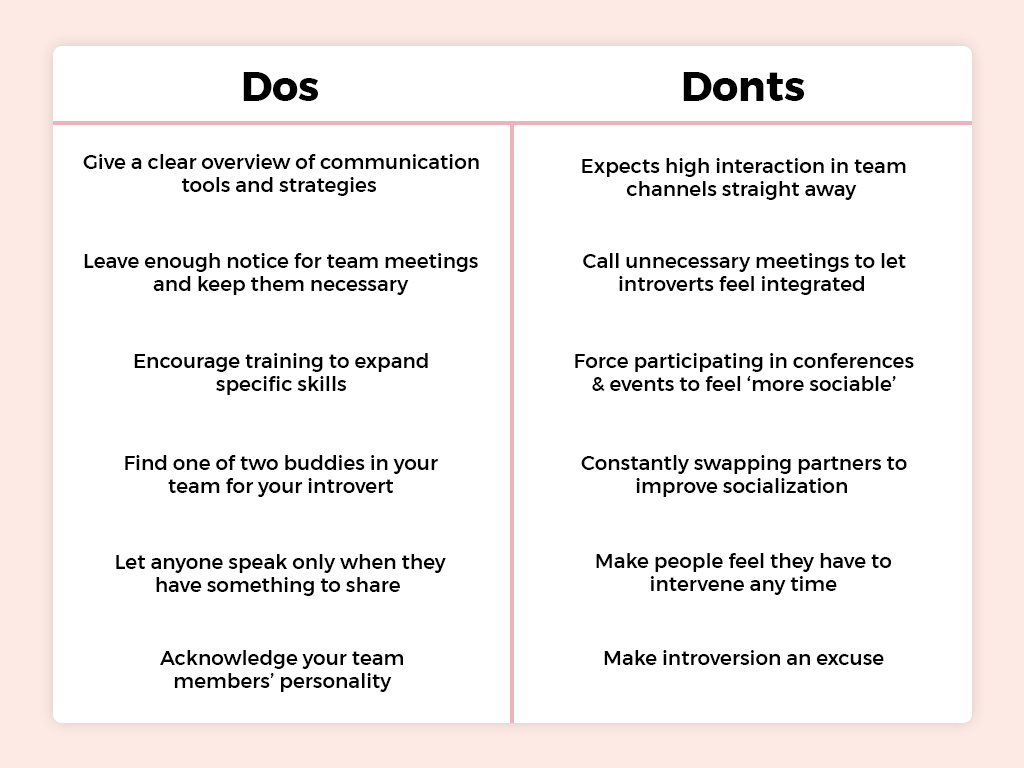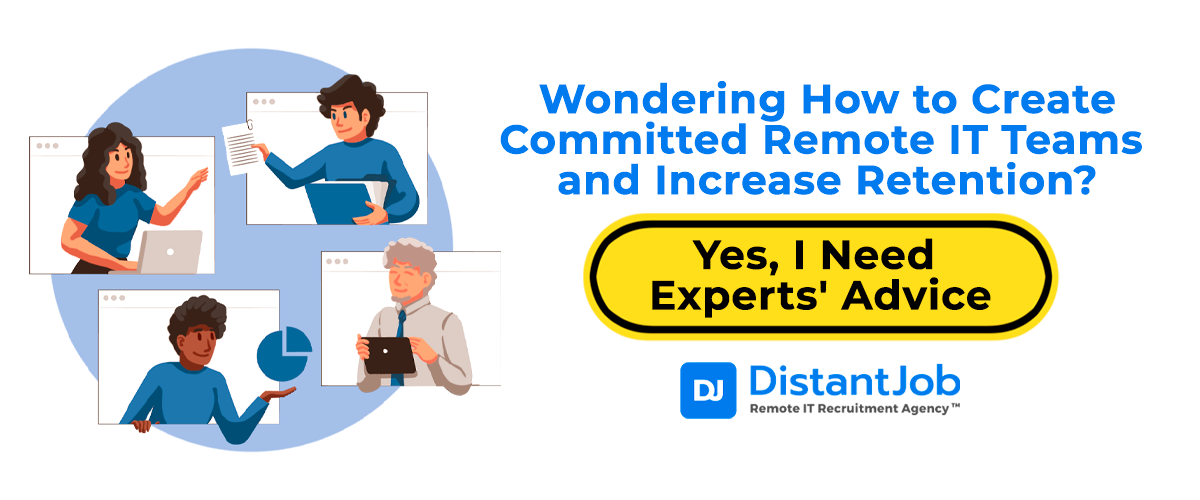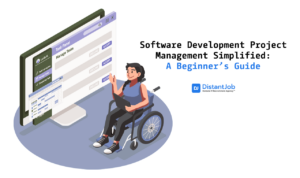Have you ever heard of the so-called ‘wallflower personalities’? We all have that type of friend. The one who never hangs out on Friday and goes to parties to hide in the coat closet. If you didn’t get it so far, it’s another name to talk about introverts. They are great and reliable friends. The best ones to have a peaceful conversation over eggs benedict and enjoy actual Netflix and Chill. However, engaging introverts in a remote workplace can be challenging.
On the surface, remote work might fit perfectly with an introverted personality. You can participate in meetings from a distance, rely on asynchronous communication, and work independently on tasks. However, this isn’t always the case.
According to Virginia research firm Greater Divide’s survey, extroverts are less likely to experience mental health issues due to quarantine and remote work than introverts. In the same vein, Tribe’s research shows that 13% of introverts would prefer to return to the office after the pandemic. Likewise, 30% find it harder to build connections with co-workers working from home.
The real question isn’t which personality suits better with remote work. But how to find effective strategies on how to engage introverts in a virtual workplace.
What Is A Wallflower Personality?
According to the Urban Dictionary, a ‘wallflower person’ is the one who hides at parties and tends to be reserved when surrounded by many people. This type of personality can come across as socially awkward. Simply, they prefer to spend time with a few, selected, people and never try to get too much attention.
The Oxford Dictionary, rather than saying ‘they hate parties,’ defines an introvert as someone generally more concerned with intimate thoughts and feelings than external things. In the 20s, psychologist Carl Jung introduced the terms introversion and extroversion to identify two different types of personality. After that, this distinction became the core of theories on personality types like the Myers-Briggs Type Indicator (MBTI). Most of these theories recognize a certain degree of both opposites in each of us. However, people often act based on one of these two types of personality.
Introverts tend to be more quiet and reserved, using introspection as a lens to understand the world. Unlike extroverts, they feel drained after long and intense social interaction and need some alone time to recharge.
Common traits of introverts are:
- Independence
- Self-awareness
- Quietness
- Rising energy when dealing with ideas
- Solitary activities
- Smaller social circle
- Observe situations clearly and objectively.
What Makes Introverts So Great In The Remote Workplace?
Unlike extroverts, the beauty of a wallflower personality is their need to analyze and ponder what is being said. As a result, if you get an answer from them, it is generally well thought out and an excellent contribution to the conversation. That’s the first benefit of introverts in the workplace.
As Forbes states: “Introverts have a wealth of natural strengths — they assess situations before acting, they listen to the ideas of others, and they are skilled at taking independent action.”
In remote teams, introverted personalities are usually the best ones in planning schedules and tasks. As attentive observers of others, they quickly understand how to pair team members and distribute tasks according to anyone’s skill-set. Introverts usually like to prepare things ahead and leave enough time for unplanned scenarios. So, you can benefit from their talent to organize your teamwork. And leave extroverts dealing with everything that relates to socialization or meeting many people at once.
Finally, introverts might don’t speak a lot. But it doesn’t mean they don’t think or carefully observe what is happening around them. For this reason, introverts in the workplace are great at keeping track of meetings and expectations or reporting different stages of a project. For example, if you need to present a yearly report to clients, an introvert will do the most accurate research preparing detailed slides to illustrate the project. On the other hand, an extrovert can give justice to such deep research by engaging the audience and pointing out relevant data.
You can use both personalities to achieve the best performance for your company. Being a team player is essential for both types of characters. And if you make them work together, they will both contribute to your project. So, engage in teamwork and casual conversation. However, in the case of introverts, remember that significant social interactions will be more natural with some notice!
How to Understand and Engage With Introverted Members of Your Remote Team
- Never accept introversion as an excuse
- Don’t put introverts under the spotlight
- Identify the type of introvert you are working with
The first step to engaging with introverts in the workplace is never accepting introversion as an excuse. It’s OK to leave time to those who are shy or prefer to think about their intervention. However, it can’t turn into a pattern in which only extroverts lead the way while the rest lie on the back.
A second step is to organize a fair working schedule for everyone. You don’t need to constantly put introverts under the spotlight (you will get the opposite result!). The point is to ensure a suitable space to contribute to for everyone. In virtual settings, regular video meetings are necessary to keep team members up to date on progress and goals. During these meetings, create breaks in the discussion to ensure the right balance among all team members. Or you can use humor to chill the atmosphere and play with each personality trait while calling for feedback.
The final step is to identify which type of introvert you are dealing with. That’s right. All introverts have their own way of avoiding people. So, make sure to identify and share different workstyles to combine them in your favor. If you know the skill-set and personality of your team members, you can organize your workflow so that anyone feels comfortable giving you the best results they can.
Let’s have a look at the different types of introverted personalities and how to engage with each of them.
Different Types of Introverts and their Characteristics
Remember when we said the terms introvert and extrovert appeared in the 20s with Carl Jung? Since then, many researchers have expanded the definition, finding common traits and differences within the same type of personality. In 2011, psychologists Jennifer Grimes, Jonathan Cheek, and Julie Norem found four main types of introversion: social introvert, thinking introvert, anxious introvert, and restrained introvert.
1. Social Introvert
Social introverts like occasional gatherings with family or friends but value alone time more than anything else. As psychotherapist Anthony Freire states: “A social introvert doesn’t avoid crowds because of anxiety but rather [because of] their preference. Where they feel the most comfortable and happy is either incomplete solitude or in small groups in more subdued places.”
Common traits and habits of social introverts:
- Preference for intimate gatherings
- Regular solo date or vacation
- Need for alone time to recharge – especially in a relationship
- Doesn’t oppose social invitations but is unlikely to go
Working remotely with a social introvert:
A social introvert works better in small groups and asynchronous tasks. They prefer to combine their social interactions with alone time to think about a situation and possible course of action. The best way to engage them is to combine regular meetings with a small group and assign specific tasks. You can rely on punctuality, precision, and a well-thought perspective. Over time, they will open up with their co-workers and actively contribute to your team.
2. Thinking Introvert
As clinical psychologist Carla Marie Manly, Ph.D., explains: “The thinking introvert is very cognitive by nature. Often intellectual, this type of introvert is often at peace when studying, reading, learning, researching, and investigating.”
Thinking introverts always think carefully of their answers – “Let me think about that” is one of their most common answers. They are great listeners, and their introversion helps them find the best way to deal with people and their problems.
Common traits and habits of thinking introverts:
- Introspection
- Preference for activities such as studying, reading, researching, or other creative activities
- Take time to think about answers or opinions
- High self-awareness
Working remotely with a thinking introvert:
This type of personality works at its best doing research and activities that require an individual approach. In this case, you can rely on them for insightful reports and deep analysis. Introverts’ personalities can find helpful information for your team and give you an alternative perspective on what was done. As thinking introverts take time to think of answers, they are a massive support for decision-making and new strategies. In addition, these personalities are great listeners and moderators when discussion occurs. If you give them tasks of this kind, you will leave them in their comfort zone. And they will focus on results instead of worrying about social interactions.
3. Anxious Introvert
This type of introvert usually shies away from other people and may appear agitated or on edge. They can be painfully shy in public and often battle with feeling self-conscious of their perceived lack of social skills. Anxious introverts do not like attention drawn to them and embrace the phrase ‘wallflower.’ The high defense mechanism and the scientific attempt to avoid others make them rude (very directly) in social situations. They give their best in their comfort zone and struggle to adapt to changes or new people.
Common traits and habits of anxious introverts:
- Typically act nervous in most situations
- Highly avoidant and rude behavior
- Constant effort to avoid social interactions
Working remotely with an anxious introvert:
To deal with anxious, introverted people, you need to find the right buddy for them. They tend to open up to close friends and people they trust. So, pair them with different team members on multiple tasks (without going too wild with social interactions). If you notice that they feel more comfortable with some team members, you can arrange tasks to let them work together and slowly introduce the rest of the team.
4. Restrained Introvert
The restrained introvert, or the inhibited introvert, is more reserved and highly values personal space. Instead of being shy or avoidant, this personality comes across as thoughtful and grounded. They methodically analyze any situation and person, building trust before opening up to others.
As Manly explains: “the restrained introvert tends to be reflective and even plodding in nature. Often unemotional, this type of introvert is often very controlled and may have very grounded energy. […] The restrained-type introvert is often the quiet, dutiful person that others tend to rely on.”
Common traits and habits of restrained introverts:
- A slow and systematic approach to things
- Preference for predictable activities
- Sometimes unemotional and calculator
Working with a restrained introvert:
The good side of this personality is that it likes long relationships. Restrained introverts take time to open up, but they are loyal, grounded, and insightful once they do. They will grow with your company and take care of other team members aware of the ‘introverts’ struggles.’ What you need to do is gain their trust as a person. Show them that you know how to do your job, but not at the expense of their happiness. Their systematic approach will be a valuable asset for your planning and distributing tasks among team members, once they trust you.
Do’s and Don’ts of Managing Introverts In The Remote Workplace
How do I know if my employees are introverts? Well, if one of your team members isn’t very talkative and takes more time to integrate, then you have an introvert. However, working with a wallflower personality doesn’t mean working with a hermit. You just need to find creative strategies to increase your introverts’ engagement and encourage them to speak.
To recap, here are some dos and don’t to engage introverts in a virtual workplace:

Understanding Your Remote Team’s Personality
When you’re willing to understand how to communicate effectively with your employees, you’re already paving the way to success. But when you go the extra mile to understand specific types of needs of your employees, especially remote workers, then you’re going to be harvesting the fruits of your labor for a long time to come. Engaging with introverts in the workplace is a challenge, but not impossible – and they can add significant value to your team.
And remember, understanding your team members’ personalities is the key to a successful hiring process. If you know that your team will benefit from a grounded and calm nature, you seek an introvert. When you need someone passionate and able to convince anyone about a project, you want an extrovert. Both personality types are great, but you need to know what your team needs.
For the rest, you can ask us! We are a headhunting agency specialized in remote IT hiring. Our mission isn’t only finding the right skill-set but the right personality – because we know how much company culture matters in the long run. If you need a new remote developer for your team, contact us!




